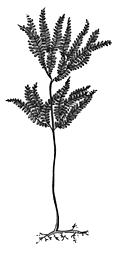
Description: Rhizome long-creeping, wiry, hairy.
Fronds branched one or more times, each pair of lateral branches spreading to produce an umbrella-like layer of pinnae; lateral axes pinnately divided, the pinnules oblong or linear, usually undivided, often glaucous below; lamina glabrous or covered with stellate hairs or scales; veins free, usually forked once.
Sori numerous on each segment, in a single row on each side of the midvein, usually composed of 3–5 sporangia (but varying from 1 to 6).
Distribution and occurrence: World: c. 80 species, pantropical & Southern Hemisphere. Australia: 5 species, Qld, N.S.W., Vic., Tas.
Text by Peter G. Wilson
Taxon concept:
| | Key to the species | |
| 1 | Primary lateral axes lacking pinnules between the main rachis of the frond and the first dichotomy; pinnules finely toothed to their bases | Sticherus flabellatus |
| Primary lateral axes bearing pinnules between the main rachis of the frond and the first dichotomy; pinnules entire or the margins obscurely crenate | 2 |
| 2 | Lower surface of the pinnules glabrous; lateral axes bearing ovate to lanceolate, shortly fringed scales, glabrescent | Sticherus lobatus |
| Lower surface of pinnules covered with pale brown branched and simple hairs; lateral axes sparsely covered with narrow, heavily fringed scales
Back to 1 | Sticherus urceolatus |
|


